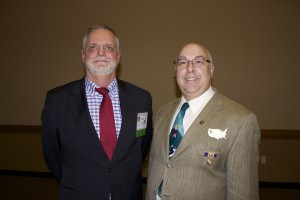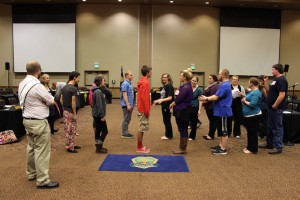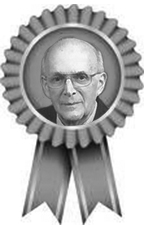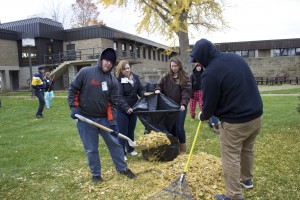Day 5: National Grange 148th Annual Convention
 |
 |
Two elected to National Grange Executive Committee |
| BY SUZY RAMM DCI Communications Fellow | gb*******@******ge.org
Leroy Watson, a 42-year Grange member, who serves as Treasurer of Fox Valley Good Earth Grange #776 in Neenah, Wisc., and Overseer of Potomac Grange #1, D.C., picked up his first seat as an officer of the National Grange with Thursday’s vote. “I’m deeply honored to receive the confidence of a majority of the delegates of the National Grange to serve them on their Executive Committee. I am looking forward to working with the fellow members of the executive committee, our state masters and Grange members across the nation to advance the interests, elevate the character and increase the influence of all Patrons of Husbandry.” Watson replaces Betsy E. Huber, of Pennsylvania, who served on the board since 2006 and has been board chair since 2007. Watson, a native of Vermont where he still owns and operates his family farm, has served as the Special Director for Trademark Protection and Brand Management since August 2007. He was also the Legislative Director from 1999 until 2010 and Legislative Assistant from 1985-95. He also served as Legislative Director of the Vermont State Grange, and as legislative assistant for both the Vermont Farm Bureau and Vermont State Employees Association. He has a degree in political science from the University of Vermont, and a law degree from George Mason University in Arlington, VA. He also studied administrative law at the University of Exeter in Exeter, England, and is admitted to the Bar of the Supreme Court of Pennsylvania. Watson and his wife, Cheri, and daughter, Rachel, 12, reside in Appleton, Wisc., but will soon relocate to Walpool, N.H. He is Overseer for Potomac Grange #1 and serves on the National Grange Historical Committee. Duane Scott, Master of the Wisconsin State Grange, returns to the Executive Committee for his third term. Scott was National Grange Steward from 2001-07. He has served twice as Wisconsin State Master from 1997-2003 and reelected in 2009, serving through today. Since he was 5, Scott has been affiliated with the same Grange, first as a Junior Granger with La Prairie Junior Grange #19, then as a subordinate member of La Prairie Grange #79. He has held nearly every office open to a man in the Grange. Scott, of Fort Atkinson, Wisc., said upon re-election he plans to “continue working to build membership and encourage our members to gear up for the 150th Anniversary” as well as “re-forge our fraternal bonds and grow our family organization.” He has been employed at the Jefferson County Sheriff’s Office since 1986 and currently holds the rank of Captain. He and his wife, Kymm, have been married for 29 years and were members of the 1996 National Grange Youth Team. They have a daughter, Amber, 23. The executive committee members will meet after installation on Friday to vote for a new chairman. |
+1 Junior Program takes off in Oregon |
| BY SUZY RAMM DCI Communications Fellow | gb*******@******ge.org Last year the Junior Grange +1 program was approved, allowing Subordinate Granges to have individual Junior members join their ranks and take advantage of all the Junior Grange has to offer. Several Granges have seen this program as a great benefit. In Oregon, 32 children have joined the Junior Grange as +1 members across 18 different Subordinate Granges. “Once the +1 Program was adopted at last year’s National Grange Convention Oregon got right down to work, figuring out how to implement it in our state,” State Master Susan Noah said. “I am extremely pleased with the success of the +1 Junior Program in our state.” Noah said during the first quarter, a synopsis of the program, the Junior obligation and two Junior applications It was the headline of the Junior Directors column in the March state paper and directions on how to report these new members were included with the quarterly report form when it was sent out. Soon the state Grange office started hearing from Granges taking in Junior members. Noah said two Pomona Granges in the state are working to gather the individual Juniors in their local Granges in to Pomona Junior Granges. Expectations are for another one or two to do the same. “I think it’s a really great program that opens the Junior Grange up to more children. I hope when others hear the success we’re already seeing in our state, they will work to promote the program in their states as well,” Noah said. |
Director of ‘Dictionary Project’ attends Idea Fair at National Convention
|
| BY KARIE BLASINGAME DCI Communications Fellow | Kb***********@***il.com Since 2002, the Dictionary Project and the Grange partnered to provide children with dictionaries. More than 768,000 books have been donated by more than 850 Granges through this partnership. For many years, Arno French, the co-founder and President of the Board of Directors of The Dictionary Project, was the liaison that Grangers saw as friendly face promoting a program at the Idea Fair for many years. After French passed away in 2012, his wife, Mary, attended the 2013 convention. This year, a new face is seated at the Idea Fair to represent the organization – Allie Osuch, Outreach Director for The Dictionary Project. “We are thrilled to be able to meet Grangers at the National Convention to thank everyone for all the good work you do, as well as partnering with us to bring dictionaries to students,” said Osuch. As of Thursday afternoon, Osuch had given away more than 50 boxes of dictionaries for members to give to children in their communities. “Our members love this program,” National Grange Sales, Benefits, Programs and Membership Recognition Director Samantha Johnson said. “It’s an affordable way to give to the children and allow them to learn new skills.” |
Youth Officer Team arrives in Sandusky
|
| BY LINDSAY SCHROEDER DCI Communications Fellow | lr*********@*im.com
“It is really something special for a Grange youth to put on a National sash and be recognized by their peers. Friday morning is always exciting time as hundreds of Grangers pack into the hall to watch the youth open session,” National Youth Development Director Charlene Espenshade said. Leadership development and learning how to work in a team are two life skills that every youth and young adult member needs for success, Espenshade said. Even adult officers of the National Grange take notice of the hard work of the youth. “It’s always great to watch the team step up to the challenges of learning and executing the morning’s work,” long-time youth supporter and National Grange Steward Chip Narvel said. The team is part of a larger group of youth, chosen to attend session, workshops and the practices to gain skills and experience that will enhance their Grange knowledge and skill set for life. For the past several years, much of the expenses of the program have been covered by generous donations to the Grange Youth department, many through the Grange Foundation, by members and by a grant from Farm Credit. Espenshade said she was just informed at the beginning of this week that in 2015 Farm Credit will again sponsor the youth program. “This will go a long way to helping secure the program for next year, but without the support of our membership, |
Justi was also NJHA icon |
| BY DEBBIE GEGARE DCI Communications Fellow | de*******@***oo.com
Wib continued to attend national NJVGA conventions and in 1942, he was elected a National Youth Officer. When he was elected National Vice President in 1943, he didn’t hold the title long as the National President was called on to military duty and Wib assumed the position. He continued to serve on the youth officer team in 1944. That was also the year that June attended her first NJVGA convention. Wib and June continued to attend many conventions after they got married in 1946. He held many important positions in the organization including Advisor, Executive Secretary, Historian, Board of Trustees and Alumni. He was very instrumental in the growing of the organization, which became NJHA in 1964 as he was great friends with Grant Snyder, the founder of NJVGA/NJHA. He was a foundation stone for NJHA. He loved working with young people, it was his whole life. He was a positive example and inspiration to everyone he met. His legacy lives on in those who knew him. |
Green option added for Justi tribute shirts |
| BY DEBBIE GEGARE DCI Communications Fellow | de*******@***oo.com On Thursday, a kelly green shirt – reflecting first National Grange Youth Director Wib Justi’s favorite color – was added to the youth fundraiser t-shirt sale. The new shirt will be available with the same design at the same price. For the six indviduals who purchased the blue version before having the option, simply email he**@*****er.com and tell them your name and that you would like to change your blue Wib Justi tribute shirt to green. You may also change the shirt size until Dec. 1, again by sending an email to he**@*****er.com. Even though Potomac Grange #1, D.C., the sponsoring organization for the fundraiser, has set a goal of selling at least 150 shirts, there is no limit to the number that can be sold but the sale ends Dec. 1. Potomac Grange #1 Steward Amanda Leigh Brozana said the group was advised to choose 150 shirts as a goal, but hopes to far exceed that. She said each shirt sold will return profits for the Grange Youth Fund in the Foundation, but with Booster, the more shirts sold, the larger the profit margin and thereby the larger the donation. “You can sell far above or below that number, but it just gives them an idea for stock. If they know what to expect, they are able to fulfill the order faster than if they have to wait for more shirts before they can print them all.” To make this campaign successful, Potomac Grange Lecturer Samantha Johnson said everyone should take a moment to share information about the sale with their friends. “Put it on Facebook, call your friends and tell them about it, email your Grange. All of it will help get the word out,” Johnson said. Brozana encouraged members to contact their Grange before Dec. 1 and do a bulk order for anyone interested. “We hope members will return home and ask their friends and fellow members if they’d like a shirt, then create bulk orders so as to keep the shipping costs down and get everyone a shirt who wants one, “ Brozana said. “It’s only $5 shipping no matter if you purchase one or 100 shirts, so if you know your mother or your youth team or your pen pal from the Germany-USA program would like a shirt, buy one and give it as a gift for Christmas or collect the cash from your members and buy a bunch.” |
Fitch serves as National Grange Convention Legislative intern |
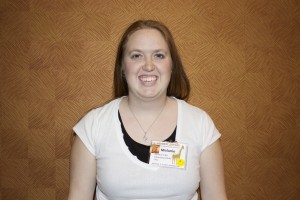 Melanie Fitch, a member of Olivesburg Grange #264 in Ohio is a third-generation Grange member. She is a third generation Grange member on both sides of her family. Currently, she attends the University of Akron where she is a senior majoring in Business & Organizational Communications-Public Relations. Fitch, the Gatekeeper of her local Grange, is also the Olivesburg Grange Youth Chairwoman. In addition, she is the Olivesburg Grange Youth chairman. In 2008 she represented Ohio as the Ohio State Female Youth Ambassador in Grand Rapids, Mich. Also, she was the 2008 recipient of the National Grange “Jeff Wetzel National Leadership Award.” During the summer of 2012 she was appointed a National Grange Deputy and was sent to Wisconsin. In her state she has participated in many of the public speaking contest and this year she competed in her first Sign-A-Song competition. Melanie Fitch, a member of Olivesburg Grange #264 in Ohio is a third-generation Grange member. She is a third generation Grange member on both sides of her family. Currently, she attends the University of Akron where she is a senior majoring in Business & Organizational Communications-Public Relations. Fitch, the Gatekeeper of her local Grange, is also the Olivesburg Grange Youth Chairwoman. In addition, she is the Olivesburg Grange Youth chairman. In 2008 she represented Ohio as the Ohio State Female Youth Ambassador in Grand Rapids, Mich. Also, she was the 2008 recipient of the National Grange “Jeff Wetzel National Leadership Award.” During the summer of 2012 she was appointed a National Grange Deputy and was sent to Wisconsin. In her state she has participated in many of the public speaking contest and this year she competed in her first Sign-A-Song competition. |
12 memorialized at service |
| BY DEBBIE GEGARE DCI Communications Fellow | de*******@***oo.com Over the past year, several individuals who made significant contributions to the National Grange proceeded “to the Great Grange in the sky” including a sitting State Master, Ted Doane of Nebraska, and a past delegate from Ohio who was co-chairing the coordination of this national convention. They were honored during a memorial service at the 148th Annual National Grange Thursday, led by National Chaplain Barbara Borderieux. National Master Ed Luttrell began the service with a call of remembrance to our departed brothers and sisters. “They have served our Order in many positions supporting our traditions of faith, patriotism, leadership and family values. Let us remember them in our hearts, minds and prayers,” Luttrell said. Poems were read by the Graces of the National Grange during the program, then a roll call was given by National Included in the program was the first National Youth Development Director Wib Justi and another long-time employee of the Grange, Georgia Taylor, affectionately known as Mrs. T. Representatives from the states who lost members and the Executive Committee of the National Grange provided tributes to those passed. Each past delegate and staff member was fondly spoken of, especially for their commitment to the Grange. |
Germany-USA program a lasting legacy of Wib Justi |
| BY SUZY RAMM DCI Communications Fellow | gb*******@******ge.org At the November 1949 National Grange Convention in California, a resolution passed that the organization should get involved in international youth exchange activities. Wib Justi, who had just become the National Grange Director of Youth Activities, was appointed to develop the program. From then until 1966, Grange families across the U.S. hosted 1,718 young exchangees from 39 countries. Developed as part of the international youth exchange activities, the German-USA program was one of the most well-known and longest running successes. Under this program farm youth from Germany were brought to the United States and placed with Grange farm families for one year to directly experience the benefits of freedom, prosperity and democracy. It provided opportunities for young Germans to learn about procedures they could use in the free land, to improve themselves, and to build good relationships between Germany and the United States. The program was to last 6 years, Justi recalled in articles written about the project. From 1950 through 1956, 500 young people were brought to the United States from Germany by the Grange to live this experience. These exchanges had long-term results for the participants. In an article written about one of the exchange youth, Ottilie Solver, a member of the first group of exchangees from Germany, remarked that coming to the United States “was a very special honor for me. My one year stay in the United States influenced my life.” A year after she return home she was offered a position in a land surveying office in Mosbach, in part because of both her spoken and written English skills. She continued in that position until her retirement. In another article, Susie Trenkler, a 1953 exchange student who went to Iowa, said the exchange ultimately resulted in her immigrating to the United States. She made her home in Alabama where she was reported to have owned her own laundry business. She said this was all made possible because her American host mother, upon passing away, had left her the money to open the business. The same was true for Konrad Weniger, according to his story in a publication decades after his exchange experience. He, too, was part of the first class of exchanges who, after returning to Germany, immigrated to the United States and had a successful career in California. For Justi, according to his own words, these programs would prove to be his life calling. He remained active with international youth exchange programs and was responsible for placing 1,918 young people in homes throughout America, most with Grange families. In 2009 when Wib and June Justi were included in the inaugural class of Hero’s of the Grange, Wib Justi said, “One word…courage. Please think of the word courage when you think of the German exchanges in the GG/USA program and their American host families when they accepted one another at a time immediately after WWII. This tribute is for these people. |
Session tours take the safari to space |
| BY CHRISTOPHER R. SZKUTAK DCI Policy & Communications Fellow | cr******@***il.com
Delegates, youth, and general members visited the NASA Glenn Research Center Plum Brook Station in Sandusky, Ohio, this week. Delegates went on tour Wednesday morning while youth and general attendees went Thursday.This 6,400 acre site is home to the Space Power Facility, which houses the world’s largest Space Environment Simulation chamber. Vicki Huff, Master of the Maine State Grange explained why she thought the tour was such a positive experience. “Our tour guide was amazing, he explained everything in a way we could understand though he was talking about complicated scientific issues.” According to NASA, this 122 ft. high vacuum chamber makes it possible to perform development and flight qualification testing of full-scale space flight systems in vacuum and temperature environments similar to that of space. The chamber has been used to test planetary landing systems like the Mars Pathfinder and the Mars Exploration rovers’ airbag systems. Also at this location is a Vibroacoustic Highbay, a vacuum chamber that can be configured to perform reverberant testing in addition to thermal vacuum testing. NASA says this chamber simulates conditions experienced during launch and ascent. Thermal vacuum testing will simulate the extreme temperature environments experienced in orbit. National Youth Development Director Charlene Espenshade said the experience, while excellent for adults, is especially beneficial for school-age youth. “Many of our Youth who attend session have to take ‘educational field trip’ absences from school. While the whole convention is educational, a tour to a facility like NASA absolutely bumps up the experience,” Espenshade said. |
Part II: Volunteers in the new millennium |
| BY KARIE BLASINGAME DCI Communications Fellow | Kb***********@***il.com Maybe it’s the focus many high schools are putting on community service, but volunteering is very important to millennials, research shows. However, research also shows volunteering and finding opportunities differs for this younger generation than their parents and grandparents as we learned in part one of this series. Those born in the 1980s and 90s are looking for different ways to learn about service and projects they can be a part of according to researchers, but for Grange Youth, the organizations they join like the Grange are the first source for service opportunities. National Grange Youth Development Director Charlene Espenshade said that our Grange youth do actively pursue other volunteer activities. “They participate in what is available and if they discover a need, they find a way to fill it,” Espenshade said. Grange Youth in attendance at the 148th Annual National Grange Convention spoke about their volunteer experiences. Emma Edelen from Iowa says that she “seeks out volunteer work when she has free time at college.” She recently helped out more than was expected of her with her college sports teams. When her school sports teams were decorating trees and putting up light displays, Emma decorated many trees, going back multiple times, instead of the one time that was required. She is also involved in a volunteer club at school. Edelen will also ask around to other organizations to see if they need a hand and is always checking the sign boards at her college to see if she is able to help out. She enjoys helping at the humane society and has never used an online source to find volunteer work, but sees it as an avenue she may pursue. Rory Neer, a youth from North Carolina who attends college at the University of Florida, does much of his community service through the fraternity he is a member of. Neer said he believes in giving back and helping out. His fraternity raises money for the local children’s hospital by helping plan and host a dance marathon. Neer believes that online sources for volunteer work are “definitely a resource” that he will use in the future. Trevor and Clifford Gervais, of Connecticut, both volunteer with FFA and 4-H, but don’t necessarily search out other forms of volunteer work. |
Youth Service Project helps veterans |
| BY KARIE BLASINGAME & LINDSAY SCHROEDER DCI Communications Fellows | Kb***********@***il.com | lr*********@*im.com
The 99-acre Ohio Veterans Home has the capability of housing up to 700 residents. It includes both an independent living wing and a nursing home. Dwayne Henson, the grounds manager of the facility, instructed the youth on their duties, including raking leaves and hanging Christmas lights in a courtyard area of the home. More than 50 youth and chaperones participated in the clean up and decoration efforts. Trevor Gervais, of Connecticut, said that giving back, especially to veterans, is important to him. “It’s really cool to help out veterans, especially since Veteran’s Day was this week,” said Rory Neer, Ambassador from North Carolina. Lexi Gegare, of Wisconsin, said she was also excited to work with veterans. “I’m really excited to be working at a VA home, it’s great to give back to people who gave for us,” Gegare said. Gegare has been running a project for the past three years collecting holiday cards for active duty soldiers and will be doing so again at convention this year. National Grange Youth Development Director Charlene Espenshade said this project was different than what had been done by youth at convention in the past because of its tie to the holidays but that it was well-received. It took the youth about an hour to hang lights on six balconies, three Christmas tress and other spots around the courtyard. They also cleared the entire courtyard of leaves as well as a ramp from the second story. |
Agriculture in 2014: Agricultural Education
|
| BY CHRISTOPHER R. SZKUTAK DCI Policy & Communications Fellow | cr******@***il.com
“The Grange urges educators at the primary, secondary and undergraduate levels to include basic knowledge of agriculture in their curriculum,” National Master Ed Luttrell said in his Annual Address. Children having a basic knowledge of agriculture leads to more informed adults who support agriculture with their wallets and in the voting booth. There are many organizations working to promote agricultural education. Here are a sampling of organizations, their history and missions. Agriculture in the Classroom Today, all fifty states, as well as the territories have state organizations. Each state organization is different, some are independent non-profits or foundations, others are housed in larger organizations like Farm Bureau. In some states leadership is provided through the departments of education, agriculture or other government agencies; in other states through agriculture organizations or commodity groups; some through universities or colleges; and in some cases through the dedicated efforts of one or two individuals. The stated mission of AITC is “The mission of Agriculture in the Classroom is to increase agricultural literacy through K-12 education.” The deployment of resources in each state program is also different, some states send volunteers directly into the classroom while others have teacher workshops and write lesson plans that teachers can employ in their classrooms. 4-H Though each 4-H club is different, many clubs do community service projects that relate directly to agriculture. Some 4-H clubs sponsor fairs where animals are shown. As these clubs are attached to an extension office. plenty of opportunities are available for these groups to be directly involved in agricultural research and to learn about more about the wide range of careers in agriculture. FFA FFA meetings are quite similar to Grange as there are opening/closing rituals and they follow parliamentary procedures to conduct their business. There are also many different contests for members to participate in. The overall focus of the organization is to develop the agricultural leaders of tomorrow and empower young people to take their place in the agriculture industry. National membership is on a steady increase, with an increase of roughly 30,000 members in 2014. Partnering with any of these organizations could help your Grange promote agriculture in your community. Tomorrow, in the conclusion of this series, we will discuss specific tips and tricks promote agriculture through your Grange. |
Talk about your Grange: Promote membership
|
| BY MICHAEL MARTIN National Grange Leadership/Membership Director | mm*****@************ge.org What must we do to grow our Grange? Well, first let’s look at our meeting places from the perspective of the community at large. Does your Grange hall have attractive, modern exterior signage? If I were to drive past your Grange hall would I be pleased with what I see? Can I read the name of your Grange from the street? Can I find a name and telephone number or email address or other contact information so I can get additional information if I would like? Is your Grange hall well-maintained? Is the paint fresh? Are the windows clean and in good repair? Is the landscaping maintained? In other words, is your Grange hall a welcoming presence? The first chance we have to promote the Grange is with the public perception of our meeting places. So, if your physical presence is attractive and positive, do your members promote the Grange? Do your members wear Grange caps, shirts, jackets, pins or jewelry? Do you have a Grange insignia on your vehicle? Do others ever ask you about the Grange when they interact with you in public? Do you talk about your Grange involvement when conversing with family, friends or work colleagues? These are the folks that are most likely to join, if you invite them. If your Grange really wants to promote itself and gain new members what new spaces can you use for this purpose? You can use new physical spaces or new technological spaces. Does your Grange have a currently updated website, Facebook page, Twitter account or other virtual presence where you can reach out to the community? Does your community have a farmers market? Have you considered taking a case of cold water, a Grange banner and some brochures and having a presence at the local farmers market? Give the water away, or take donations, and talk about what your Grange is doing in your community. Invite folks to join you for a meeting, a meal, or a community event. And then, invite them to become members. Does your community have “Olde Tyme Home Days” or some such event to celebrate and bring people together? Perhaps your Grange could have a presence at such an event and talk about the “good old days” and also talk about the “good work” your Grange is active in today. Invite folks to join you. Do you know your local agriculture teacher? If your high school has a FFA Chapter, you already have young people who are familiar with ritual and parliamentary procedure. Invite them to share a program at your Grange. And then invite them to join you. If you can get one or two to join, they will bring their friends if they are having fun and feeling valued as Grange members. Do you know your county 4-H Educator? Ask them to help bring a 4-H member of a club to present a program at your Grange. Sponsor a trophy at their round up, or provide a scholarship to camp or college. Invite them to join your Grange. |

